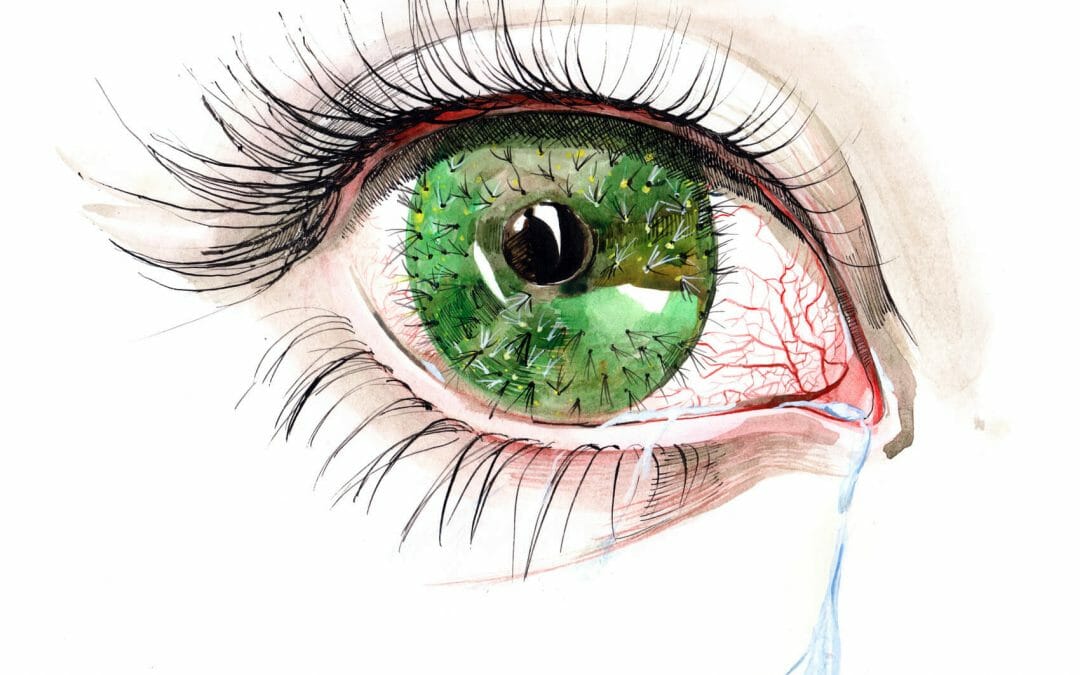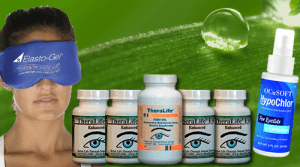The TheraLife Solution to Watery Eyes
As a leader in chronic dry eye treatment, TheraLife allows the body to produce tears naturally by promoting the production of the body’s own balanced healing tears. Eye drops will make watery eyes worse. Washing away all the natural lubricants your eyes produce.
Eliminate painful inflammation and dryness and restore your own comfortable vision. Lengthy doctor visits, eye drops that don’t work, or expensive medicines do not address the root cause of the problem which is underactive tear production.
To learn more-
Try TheraLife today for your dry eye treatment and begin your journey to healthy happy eyes.
Is your watery eyes caused by allergies and dry eyes?
Watery eyes are a common sign of allergies, but it is also a sign of something else? There are certain symptoms that signal whether those watery eyes are allergies or dry eye syndrome (DES).
How many people have allergies?
More than 50 million people suffer from allergies every year. Allergic rhinitis, also referred to as hay fever, can cause watery eyes along with sneezing, itchy eyes, and a runny nose. Allergy sufferers often find that they experience these symptoms seasonally.
How many people have both allergies and dry eyes?
However, up to 10 percent of those who believe they may have allergies, may actually have dry eye syndrome (DES).
Dry Eye Syndrome or Allergies?
Dry eyes are a common complaint for many people who visit their eye doctor. In fact, almost 5 million Americans suffer from watery dry eyes. Many people that suffer from dry eye syndrome believe that they have allergies. So how can a person tell the difference between dry eye syndrome and allergies?
No matter what type of allergen, ragweed, pet dander, or pollen, the eyes react in the same way: redness, itching, burning eyes with clear, watery discharge.
Dry eye symptoms
Dry eyes also cause eyes that are red, itching, and burning with watery discharge. However, dry eyes are not caused by allergens, but rather problems with tear making glands in the eyes, wind, or even auto-immune disorders.
Tears help keep your eyes clean and decrease the risk of developing an eye infection. Without adequate tears, your eyes may experience:
- stinging
- burning
- blurry vision
- itching
- sensitivity to light
- discomfort
Dry eye may also cause problems with your vision.
According to a 2020 reportTrusted Source, dry eye can reduce visual function and negatively affect your quality of life by interfering with your productivity and emotional well-being.
In some cases, severe dry eye may cause:
- corneal ulcers
- scarring
- permanent vision loss
Are eye drops for allergies effective?
For allergies, many doctors prescribe allergy eye drops because of their extreme success in treating allergy symptoms. However, these same eye drops that bring relief to allergy sufferers can cause the protective layer covering the eye to wash away leading to dry eye syndrome.
Tears in Action
When a particle gets in or around the eyes, tears are necessary to wash away these foreign bodies. But, excessive tearing can cause watery eyes which can wash away the protective layer that covers the eyes.
Epiphora
Epiphora, which means increased tearing, can be caused from the eyes producing more tears than necessary or a tear drainage duct not functioning properly.
The lacrimal gland produces the tears that protect the surface of the eye. Located above and behind the upper eyelid, the gland works when we blink, while the eyelid pushes the tears across the surface of the eyes.
How does tear work?
These tears collect in the lower corner of the eye where they travel through tiny holes to a nasal duct that allows them to travel down the nose and into the throat. At the same time, the lacrimal gland produces new tears and the process continues.
This is all an important process that, if interrupted, can cause a person pain, discomfort, and even vision loss.
Dry Eye Syndrome
If dry eyes last months or years, dry eye syndrome (DES) is present. Sometimes the symptoms improve but return after some time. When the tear film is washed away due to excessive watery eyes, dry eyes gets worse.
There are several reasons people suffer from DES. If the Meibomian oil glands are clogged, the quality of tears is poor (tear not thick with the right mixture of mucin, protein, and lubricants), certain medications cause the eyes to become dry, or even environmental factors cause a disruption to the tear film, DES can be present.
It is vitally important that the eyes are able to produce their own natural tears to protect the eye surface.
If the cornea becomes damaged from a lack of a protective tear film, vision loss may occur. Whether the need is increasing tears, maintaining tears, triggering tear production, or healing inflammation in or around the eye,
Frequently Asked Questions
What is watery eyes a symptom of?
Watery eyes is a symptom of either allergies, dry eyes or a combination of both. There are other reasons for watery eyes as well that are more disease related, or mishap of the eyelids.
How do I get my eyes to stop being watery?
To stop eyes from being watery depends on the root cause.
If it is allergy related, take anti-histamines should help. Beware that anti-histamines will make your dry eyes worse.
If the root cause is dry eyes, try the all natural oral treatment from TheraLife.
Should I worry about watery eyes?
Does watery eyes mean sick?
Conclusion
A watery eye is a common complaint among patients visiting the eye doctor. This condition affects all age groups due to different etiologies. It can negatively impact patients’ lives and be a manifestation of systemic disease.
Due to its multifactorial nature, a comprehensive history and workup are essential to detect the possible causes of the watery eye and treat accordingly.
References
2. Nemet AY. The Etiology of Epiphora: A Multifactorial Issue. Semin Ophthalmol. 2016;31(3):275-9. [PubMed]
3. Shen GL, Ng JD, Ma XP. Etiology, diagnosis, management and outcomes of epiphora referrals to an oculoplastic practice. Int J Ophthalmol. 2016;9(12):1751-1755. [PMC free article] [PubMed]
4. Icasiano E, Latkany R, Speaker M. Chronic epiphora secondary to ocular rosacea. Ophthalmic Plast Reconstr Surg. 2008 May-Jun;24(3):249. [PubMed]
5. Swampillai AJ, McMullan TF. Epiphora. Br J Hosp Med (Lond). 2012 Nov;73(11):C162-5. [PubMed]
6. Tse DT, Erickson BP, Tse BC. The BLICK mnemonic for clinical-anatomical assessment of patients with epiphora. Ophthalmic Plast Reconstr Surg. 2014 Nov-Dec;30(6):450-8. [PubMed]
7. Webber NK, Setterfield JF, Lewis FM, Neill SM. Lacrimal canalicular duct scarring in patients with lichen planus. Arch Dermatol. 2012 Feb;148(2):224-7. [PubMed]
8. Portelinha J, Passarinho MP, Costa JM. Neuro-ophthalmological approach to facial nerve palsy. Saudi J Ophthalmol. 2015 Jan-Mar;29(1):39-47. [PMC free article] [PubMed]
9. Zhang Y, Zeng C, Chen N, Liu C. Lacrimal ductal cyst of the medial orbit: a case report. BMC Ophthalmol. 2020 Sep 24;20(1):380. [PMC free article] [PubMed]
10. Kim JS, Liss J. Masses of the Lacrimal Gland: Evaluation and Treatment. J Neurol Surg B Skull Base. 2021 Feb;82(1):100-106. [PMC free article] [PubMed]
11. Lievens CW, Rayborn E. Tribology and the Ocular Surface. Clin Ophthalmol. 2022;16:973-980. [PMC free article] [PubMed]
12. Al Saleh A, Vargas JM, Al Saleh AS. Supernumerary lacrimal puncta: Case series. Saudi J Ophthalmol. 2020 Oct-Dec;34(4):328-330. [PMC free article] [PubMed]
13. Kang S, Seo JW, Sa HS. Cancer-associated epiphora: a retrospective analysis of referrals to a tertiary oculoplastic practice. Br J Ophthalmol. 2017 Nov;101(11):1566-1569. [PubMed]
14. Esmaeli B, Hidaji L, Adinin RB, Faustina M, Coats C, Arbuckle R, Rivera E, Valero V, Tu SM, Ahmadi MA. Blockage of the lacrimal drainage apparatus as a side effect of docetaxel therapy. Cancer. 2003 Aug 01;98(3):504-7. [PubMed]
15. Chan W, Malhotra R, Kakizaki H, Leibovitch I, Selva D. Perspective: what does the term functional mean in the context of epiphora? Clin Exp Ophthalmol. 2012 Sep-Oct;40(7):749-54. [PubMed]
16. Perry JD. Dysfunctional epiphora: a critique of our current construct of “functional epiphora”. Am J Ophthalmol. 2012 Jul;154(1):3-5. [PubMed]
17. Maroto Rodríguez B, Stoica BTL, Toledano Fernández N, Genol Saavedra I. Treatment for functional epiphora with botulinum toxin-A versus lateral tarsal strip in a randomized trial. Arch Soc Esp Oftalmol (Engl Ed). 2022 Oct;97(10):549-557. [PubMed]
18. Ozturker C, Purevdorj B, Karabulut GO, Seif G, Fazil K, Khan YA, Kaynak P. A Comparison of Transcanalicular, Endonasal, and External Dacryocystorhinostomy in Functional Epiphora: A Minimum Two-Year Follow-Up Study. J Ophthalmol. 2022;2022:3996854. [PMC free article] [PubMed]
19. Lee MJ, Park J, Yang MK, Choi YJ, Kim N, Choung HK, Khwarg SI. Long-term results of maintenance of lacrimal silicone stent in patients with functional epiphora after external dacryocystorhinostomy. Eye (Lond). 2020 Apr;34(4):669-674. [PMC free article] [PubMed]
20. Shams PN, Chen PG, Wormald PJ, Sloan B, Wilcsek G, McNab A, Selva D. Management of functional epiphora in patients with an anatomically patent dacryocystorhinostomy. JAMA Ophthalmol. 2014 Sep;132(9):1127-32. [PubMed]
21. Vagge A, Ferro Desideri L, Nucci P, Serafino M, Giannaccare G, Lembo A, Traverso CE. Congenital Nasolacrimal Duct Obstruction (CNLDO): A Review. Diseases. 2018 Oct 22;6(4) [PMC free article] [PubMed]
22. Mainville N, Jordan DR. Etiology of tearing: a retrospective analysis of referrals to a tertiary care oculoplastics practice. Ophthalmic Plast Reconstr Surg. 2011 May-Jun;27(3):155-7. [PubMed]
23. Ulusoy MO, Kıvanç SA, Atakan M, Akova-Budak B. How Important Is the Etiology in the Treatment of Epiphora? J Ophthalmol. 2016;2016:1438376. [PMC free article] [PubMed]
24. Ishikawa S, Murayama K, Kato N. The proportion of ocular surface diseases in untreated patients with epiphora. Clin Ophthalmol. 2018;12:1769-1773. [PMC free article] [PubMed]
25. Qian L, Wei W. Identified risk factors for dry eye syndrome: A systematic review and meta-analysis. PLoS One. 2022;17(8):e0271267. [PMC free article] [PubMed]
26. Cher I. Fluids of the ocular surface: concepts, functions and physics. Clin Exp Ophthalmol. 2012 Aug;40(6):634-43. [PubMed]
27. Kinoshita S, Ukyo H, Masuda N, Osawa S. Comparison of the Postoperative Outcomes of Posterior Layer Advancement and Modified Iliff Suturing to Correct Involutional Lower Lid Entropion. J Craniofac Surg. 2021 May 01;32(3):1143-1146. [PubMed]
28. Milbratz-Moré GH, Pauli MP, Lohn CLB, Pereira FJ, Grumann AJ. Lower Eyelid Distraction Test: New Insights on the Reference Value. Ophthalmic Plast Reconstr Surg. 2019 Nov/Dec;35(6):574-577. [PubMed]
29. Chen C, Malhotra R, Muecke J, Davis G, Selva D. Aberrant facial nerve regeneration (AFR): an under-recognized cause of ptosis. Eye (Lond). 2004 Feb;18(2):159-62. [PubMed]
30. Abraham ZS, Bukanu F, Kahinga AA. A missed giant rhinolith retained for a decade in a paediatric patient at a zonal referral hospital in Central Tanzania: Case report and literature review. Int J Surg Case Rep. 2022 Oct;99:107622. [PMC free article] [PubMed]





